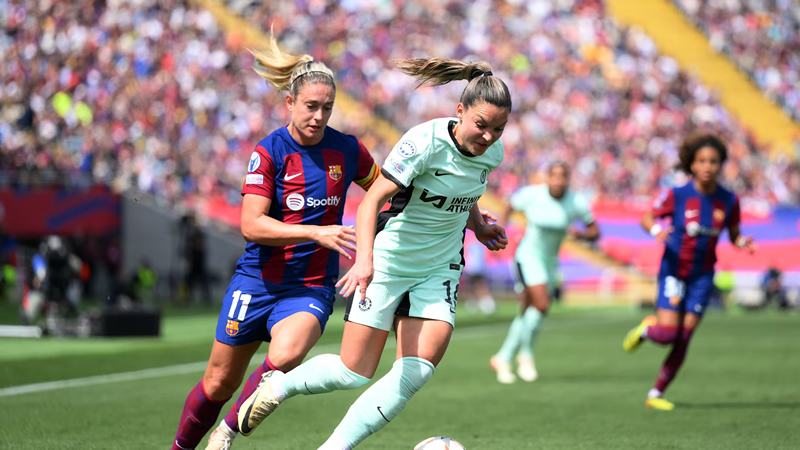The content distribution model developed by UEFA, in conjunction with DAZN and YouTube, is revolutionizing the Women's Champions League.

FC Barcelona is beginning to build a hegemony in the women’s Champions League. The latest pearl of this chain is the title won in Bilbao against Olympique Lyon. The sporting performance coincides with another parallel phenomenon that helps a history-making team reach the majority of soccer fans: the content distribution model developed by UEFA in conjunction with DAZN and YouTube.
The Women’s Champions League scheme is a remarkable case study on how to manage valuable content, but it still needs some evolution, maturation and growth to become an audiovisual business. In 2021, UEFA and DAZN put together a model that combines paid content with free TV distribution. Progressive and dynamic: launch free content, train a viewer and then build loyalty so that he/she will pay to watch.
The model coexists with the traditional sale of rights in different regions. For example, in part of South America, the decisive match was broadcast by TNT Sports.
For the first two seasons (2021-23), women’s soccer fans could watch live and on demand all 61 matches from the group stage on DAZN and for free on DAZN’s YouTube channel. In the following two seasons (2023-25), all 61 matches can be watched live on DAZN, while 19 matches are available for free on DAZN’s YouTube channel.
The multi-year agreement granted DAZN exclusive worldwide rights, with the exception of MENA (Middle East and North Africa), where the rights included video clips and highlights, and China and its territories.
DAZN found a free space and took it. In European markets it is already perceived as “the home of women’s soccer.” As a result, the platform now claims to have the largest portfolio of women’s soccer rights in the world. This positioning was well worked with global brands to create a new form of sponsorship. Thus Visa FanZone was born.
Launched from the quarter-finals to the final of the Women’s Champions League, Visa FanZone reached fans in 170 countries and in six languages. The streaming service promoted a fan engagement solution called ‘Pep Talk’ by Visa, available in a live chat on the platform itself with polls, quizzes and prizes such as a VIP trip to the final that Barcelona had just won in Bilbao.
The quarter-finals and semi-finals in March and April generated 72 million VISA brand impressions and 890,000 interactions in the Visa FanZone.

The agreement with UEFA to bring the Women’s Champions League “TV free” offered by YouTube is a win-win model for all parties: UEFA guarantees the arrival of live content and the visibility of its sponsors to global markets; DAZN uses the content to bring fans to its platform and transform them into subscribers who are then likely to pay for other content. Finally, women’s soccer also wins as an expression that bets on the reach and amplification of an axiom that began to take hold at the 2022 European Championship in England: “It’s not women’s soccer, it’s soccer played by women”.
Before the final of the 2023 Champions League, the consulting firm Crux Sports published data on the impact of the creation of the DAZN Womens Football channel on You Tube during the first two years. The growth was rapid. Here are those numbers with some updates from 2024.
– 623,000 subscribers to the YouTube channel, making it the number one global channel dedicated to women’s soccer (currently over 900,000 registered).
– More than 1,700 videos published (currently 3,472) that have reached 100 million views since the channel was created in January 2021. (168,139,660 views at present).
– 80% of those surveyed by Crux Sports revealed that their knowledge of women’s soccer has increased as a result of their attendance to the channel.
– 96% of fans surveyed perceived that the 21/22 Champions League season received more media attention overall.
– 200 territories reached global live soccer coverage on the DAZN channel with 50 million unique channel views.
– 17% increase in views over the previous season.
– Increased interest shown by audiences between the ages of 13 and 34, with a 3% increase in female audience.
– 53% of DAZN UWCL consumption on YouTube occurred on mobile devices.
– 86% of clubs involved in the UWCL reported an increase in their fan base.
– 77% of the clubs said that the broadcasts sparked increased interest from sponsors.
– 54% of the clubs said that the broadcasts generated some kind of increase in their revenues through different channels.

These data were released just as FIFA threatened to consolidate a TV blackout in the five major European markets after failing to secure what it believed to be a fair payment for the rights to the Australia-New Zealand 2023 World Cup.
That blackout was ultimately not consummated, but FIFA began to understand that the UEFA model was the right one: a combination of rights payment and smart product outreach strategies. In any case, even without the huge publicity it usually gets compared to the men’s World Cup, women’s World Cup soccer generates more followers.
The agreement between UEFA, DAZN and YouTube is the choice of a model that privileges reach and greater visibility over potential revenue from rights sales. It is no news that women’s soccer is not on the same scale as men’s soccer when it comes to negotiating broadcasts to different territories, and the values involved are a world apart.
The alternative looks smart: to put together a strategy that can give the clubs and players of the Women’s Champions League greater visibility, allowing for greater sponsorship opportunities and recognition for all parties.
It’s not that unusual: in the CONMEBOL orbit there are clubs that manage women’s soccer and allow players to sign their own commercial contracts and use the club as a platform to improve their income. These are paths to be explored while reaching the desired equality, without waiting for the world to be fairer some day. Better to help build it.